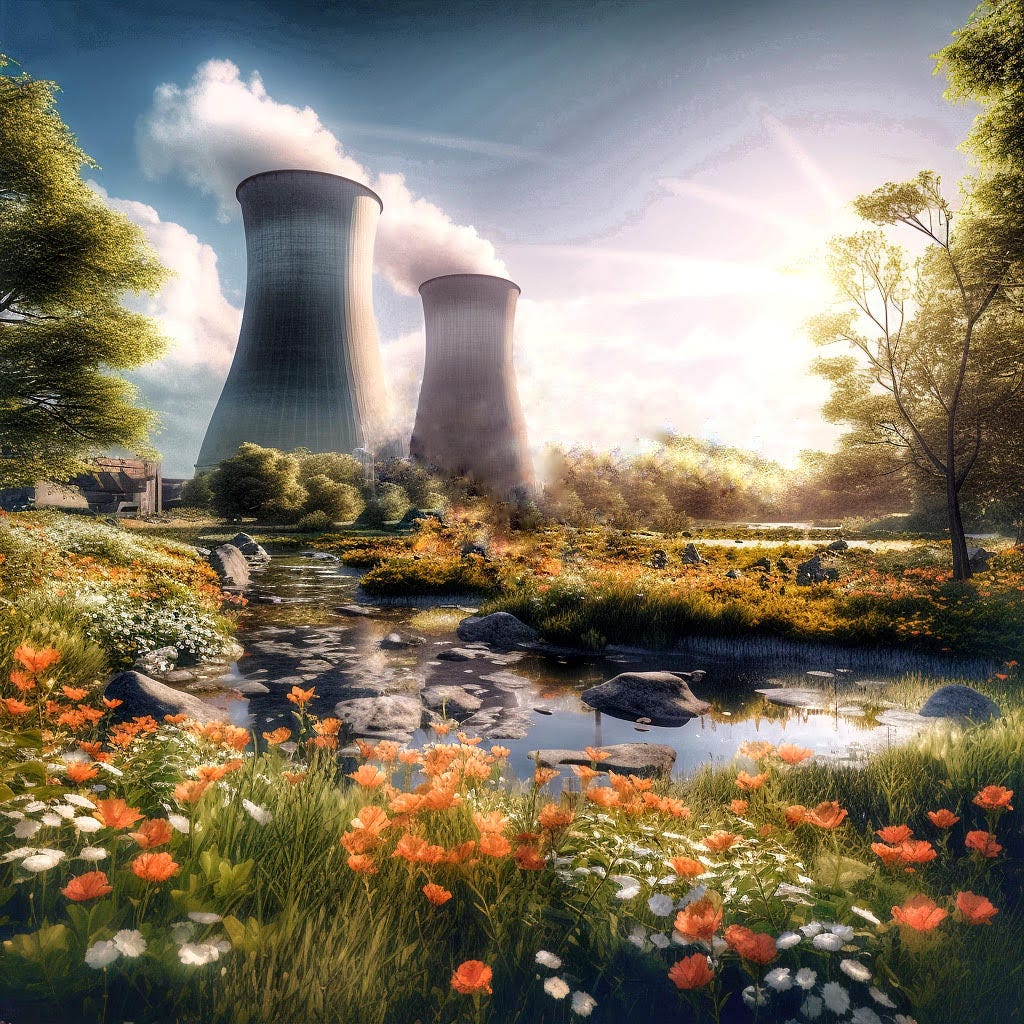Energy has become a major talking point in recent years, and energy security has become a paramount concern globally, to the extent that some countries that were once weak on energy policy have now altered course.
Nuclear energy is the most potent form of energy production, which allows societies to flourish.
A lot has changed since I last wrote about nuclear bulls and bears for The Network State, so here’s an update on what’s happening with nuclear power around the world.
Nuclear Bulls
In a world-first, 22 nations signed up to triple nuclear energy generation by 2050 at COP28 in Dubai this year, which illustrates how strongly the tide has turned in favour of the technology. Should they follow through on these commitments, the world could enter a new era of energy abundance and growth.
Most of the reactors that are under construction or planned are in Asia.
The UAE
In the UAE, nuclear energy is seen as a blessing. That’s the rough meaning of the word ‘barakah’ - the name of the UAE’s first nuclear power fleet. Barakah is one of the fastest projects in the world to deliver nuclear power, meeting as much as 25% of the electricity needs of a country with a population of over 9 million people, and it was built in less than a decade.
In 2009, the UAE accepted a $20 billion bid from a South Korean consortium to build four commercial nuclear reactors and started work on four South Korean designs (APR-1400 reactors). This was the first overseas nuclear power plant designed and built by South Korea and put their success with nuclear technology at home to the test abroad.
South Korea
South Korea’s industrial growth is largely thanks to nuclear power. The country is the world’s fifth-largest producer of nuclear energy and is now undertaking a major export drive.
After its success working with the UAE, South Korea has eyes on other nuclear-ready nations. President Yoon Suk Yeol’s recent state visit to the Netherlands resulted in an agreement to cooperate on nuclear power. South Korea is also competing with China and Russia to gain a foothold in building nuclear power plants in Africa.
China
China is building nuclear reactors faster than any other country. Over the past decade, China has added 37 nuclear reactors, reaching a total of 55. During that same period, America - which leads the world with 93 reactors - has added two reactors. China has plans to build at least 100 more reactors and currently has 19 under construction.
Interestingly, while building reactors rapidly at home, China has also been instrumental in leading public opinion against nuclear power in Japan, which shows how easily technology can be used to play geopolitics.
India
Last year India brought its indigenous reactor design online at Kakrapar Atomic Power Project.
India currently has 22 operable nuclear reactors, which produce around 3% of its electricity. India has ambitious plans to build more reactors - aiming to commission a new reactor every year.
Africa
Only one nuclear power plant is currently operational in Africa, with two reactors at the Koeberg nuclear power station which supply around 5% of South Africa's electricity production. A second facility is under construction in Egypt. Several other African countries, including Uganda and Nigeria, have made commitments to build nuclear power plants, and Ghana signed the COP28 declaration, so watch this space.
Japan
Japan has changed its mind about nuclear power. After shutting down nuclear power plants following the 2011 tsunami (which caused a power plant meltdown, which didn’t harm anybody but did turn people against the form of electricity generation), in December 2023 Japan's nuclear power regulator lifted an operational ban imposed on Tokyo Electric Power's Kashiwazaki-Kariwa nuclear power plant, and announced that other power plants would be reopened.
Finland
Last year Finland’s Olkiluoto nuclear power plant (OL3) - the largest in the world - came online.
Although it is the largest nuclear power plant in Europe, this visualisation shows the amount of land required by the Olkiluoto 3 nuclear power plant compared with the size of a wind farm that would produce similar generation.
Finland’s nuclear power plants now produce over 40% of Finland's electricity. Three of them are situated on Olkiluoto, where the world's first Geological Disposal Facility (GDF) for spent nuclear fuel, Onkalo, has been built. Finland may also consider storing spent fuel from other countries in Onkalo, which could be the future of long-term waste management.
France
France has long been a nuclear behemoth. In 1974, due to the oil crisis, French PM Pierre Messmer instigated a plan to build nuclear power plants en masse. There was a saying at the time: “In France, we do not have oil, but we do have ideas.” The idea was to build 52 new reactors between 1975 and 1990, with which France decarbonised its electricity grid and massively expanded their engineering and construction expertise.
Now, with many of its ageing reactors in need of replacement, President Macron has announced six new reactors and begun a recruiting drive for workers to get them built - but there is currently a debate taking place regarding whether the aim should be 14 new reactors instead of six.
The UK
The UK has announced plans to build a new large-scale nuclear power plant, which could quadruple energy supplies by 2050.
The UK generates about 15% of its electricity from nuclear energy, but most of this existing capacity will be retired by the end of the decade. Électricité de France (EDF) recently announced that they are planning to expand the lifetimes of some of these reactors.
As well as going big, the UK is investing in small modular reactors (SMRs) funding six companies to advance SMR technology. These are GE-Hitachi Nuclear Energy International LLC, Holtec Britain Limited, EDF, NuScale Power, Rolls Royce SMR and Westinghouse Electric Company UK Limited.
The US
The US has also changed its mind. Recent federal and state policies have recently provided support for nuclear power. In 2022, President Biden’s Inflation Reduction Act (IRA) created a tax credit for all existing reactors, designed to top off power plant revenues without overpaying.
On a regional level, several states have chosen to keep their nuclear plants online. Congress also passed two pieces of legislation to help keep power plants running. Together, these policies have saved several reactors from closing and will keep America’s existing nuclear fleet online for another decade.
The federal policies also include funding to build the next generation of SMRs. These include Bill Gates’s TerraPower, which received $80 million in federal funding from the US Department of Energy (DOE) in 2020 to support the development of its Natrium nuclear reactor, and NuScale Power Corporation, an American company that is developing SMRs, with HQ in Oregon.
Sweden
Sweden has jumped on the nuclear bandwagon. In 1980, Sweden voted to get rid of nuclear power, but now the country aims to build two new nuclear reactors by 2035. The plan is to have 10 new reactors by 2045, some of which may be SMRs.
The Swedish government has forecast that electricity demand will rise to around 300 Twh by 2045 as a result of the transition to a fossil-free society, which is an increase from around 140 Twh currently.
Energy Minister Ebba Busch said the government was planning a "massive build out" of new nuclear power by 2045.
Poland
Poland sees nuclear power as ideal for replacing coal. Though Poland has built many wind and solar farms in the last few years, nuclear reactors will be able to replace the baseload power that Poland currently obtains from burning coal.
Poland will begin building its first nuclear power plant in 2026 and is aiming for up to six reactors, with a total generation capacity of 6–9 billion watts of electricity capacity.
Czech Republic
Three energy companies including America’s Westinghouse, France’s EDF and Korea’s KHNP have submitted final bids to build the Czech Republic’s newest reactor at Dukovany nuclear power station, which should be operational by 2036. The company that wins the contract will also be invited to build three more nuclear reactors in the country.
Canada
Nuclear power accounts for around 15% of Canada’s electricity generation, with most capacity in Ontario, Canada’s most populous province. 50% of Ontario's power needs are met by nuclear power, and a total of 19 reactors provide around 13.6 gigawatts (GW) across the country.
Canada has made major announcements for new large nuclear builds, SMRs and medical isotopes. Ontario Power Generation (OPG) has signed an agreement to examine the feasibility of developing SMRs in Alberta, and New Brunswick’s latest energy strategy outlines the addition of 600 MWe of capacity at the Point Lepreau Nuclear Generation Station by 2035, which would double New Brunswick's current nuclear capacity.
Nuclear Bears
These countries are lagging behind with nuclear energy, but as events from the last year demonstrate, this could change at any time.
Belgium
Belgium, home of the Atomium, announced that it would shut down its entire nuclear power fleet in 2003. Following the energy crisis, Belgium decided to extend their existing reactors temporarily. Although Belgium’s nuclear phase-out remains in place, this March Brussels will host the world’s first-ever nuclear energy summit.
Italy
Italy may be changing its mind.
Italy once had four operating nuclear power reactors, but they have all been shut down. In 1987 Italy held a referendum and decided to phase out nuclear energy altogether.
Now, the Italian government has launched the National Platform for Sustainable Nuclear Power, which is intended to develop guidelines for possibly reintroducing nuclear power in the country.
Singapore
Singapore has not yet decided to deploy nuclear energy, but has said that it is keeping its options open and is keen to build expertise in the area. The use of nuclear energy was one of three possible scenarios previously set out by Singapore in its Energy 2050 Committee Report. A nuclear future looks likely.
Denmark
Although Denmark has not committed to nuclear power, it has for the first time established the Centre for Nuclear Energy to gather its expertise. Denmark is also home to the start-up Copenhagen Atomics, an SMR company that is developing thorium reactors as well as funding other crucial technological ventures.
Last word
According to the International Energy Agency (IEA), based on current plans nuclear power generation will reach an all-time high globally by 2025 - but this assertion does not factor in all of the proposed new builds.
This overview serves to demonstrate that despite intense, long-term activist efforts to cancel nuclear energy, wherever you look, ambitions for and investment in a nuclear future are on the rise. The questions that remain are: will the bears come around soon; who will get them built first; and will any country be able to outbuild China?






In Denmark there is another nuclear power startup that you could have mentioned. They are
Seaborg Technologies. They are developing a Compact Molten Salt Reactor.
Now that Korea and the UAE have succeeded impressively at Barakah it appears to be the best large reactor choice for countries without robust supply chains. I believe that's everybody but China and Russia. The US and Europe should build at least one large APR-1400 plant with four units to at least prime the pump